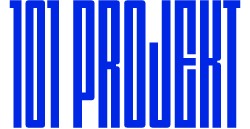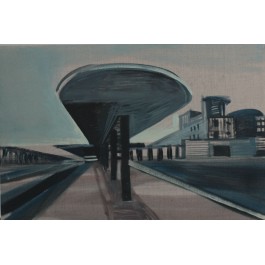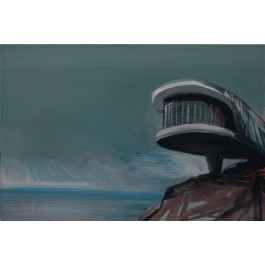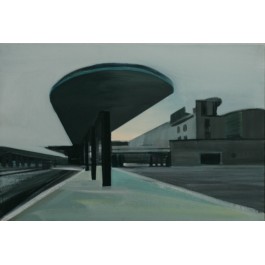The rational solid/ Exhibition of painting by Marii Kiesner
ARCHIVE EXHIBITION
THE RATIONAL SOLID / EXHIBITION OF PAINTING BY MARIA KIESNER

Artisti: Maria Kiesner
Venue: Galeria 101 Projekt, Nowy Świat 53
Date: 03-13.04.2015
In the latest paintings which make up ‘The Rational Solid‘ cycle, Maria Kiesner returns to her fascination with images of old postcards. This time she exploits issues related to the Italian modernist architecture of the 1930‘s, until recently deprecated because of its identification with the fascist regime of Mussolini, but now coming back into favor and increasingly popularized. For her inspiration, the artist used objects built in the interwar period by prominent Italian architects such as Angiolo Mazzoni (author of many public utility buildings such as railway stations in Italy) and the authors associated in the Gruppo 7 and MIAR, followers of the principles of functionalism and rationalism.
The exhibition is actually built around one theme: the minimalist buildings of the station in Siena (1934, arch. A. Mazzoni) complemented by views of others deserted seaside structures. The author is intrigued by the layout of simple solids – verticals, horizontals and slants. She selects buildings photographed in a strong foreshortening perspective. The artist presents them from several directions – from the front and from the side and from the back, trying to understand the structure of the building. She makes painting an act of reconstruction, studying their tectonics, scale, proportion. Against the background of a disturbing sky, she locates flat, gable or half round roofs, strange clock towers or horizontal forms, bending at different angles. Using the specific elements of the Italian construction - concrete open-work cages, nettings, balusters with porticos, arcades - she adds a new, more complex division of the sky.
In simple solids and structures exhibiting characteristics of not only the modernist tendency, but also the classical tradition, Kiesner finds a logical combination of functionalities, construction and form. In her paintings, exploring the relation of solid and sky or horizon, she looks for similar situations. She is interested in horror and pathos given by strong foreshortening perspective and monochromatic colors. Trying to analyze the nature and structure of the buildings she uses basic means, treating them as research tools – sparsely drawn and limited only to a two color palette, the browns and blues recalling the sepia tones of old postcards. The artist makes an apt selection of objects as inspiration, and reduces narrative to a minimum.
For 12 years, the subject of the work of Maria Kiesner were painting reflections on modern urban landscape. Whereas previously she picked up the threads of Polish modernist and PRL architecture, she now looks back to Italian Rationalism. In factories, railway stations and other public buildings, in simplified and functionalism forms she finds palladian lightness and classic dignity.
Dr. Magdalena Durda-Dmitruk
Between 1997 and 2002 she studied at the Faculty of Painting at the Academy of Fine Arts in Warsaw. She defended her diploma in 2002 under the supervision of Prof. J. Modzelewski and was honored with a J. Szajna award for searching for a new form of expression She gained an annex in poster art in Prof. M. Wasilewski’s atelier. Her theoretical work was written under the supervision of Dr. Agnieszka Morawińska. Between 2005 and 2007 she was a scholar of the Ministry of Culture and National Heritage. She paints architecture and cityscapes, presenting objects realistically, ascetically and without staffage. She is interested in factories, railway stations, schools, community centers and forgotten relics of socialist modernism and modernism. She defended his doctorate in 2009 under the title "City before the storm". She works as a lecturer at the Maria Grzegorzewska Institute of Education Artistic Academy of Special Education in Warsaw.




